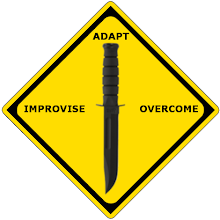"Depicts techniques of personal and equipment camouflage for survival in enemy territory. Shows different types of camouflage and shelters in jungle, desert and arctic environments. Explains how to find or construct obscure hiding places and points out areas to be avoided. Discusses restrictions on campfires."
Military camouflage refers to any method used to render military forces less detectable to enemy forces . In practice, it is the application of colour and materials to battledress and military equipment to conceal them from visual observation. The French slang word camouflage came into common English usage during World War I when the concept of visual deception developed into an essential part of modern military tactics. In that war, long-range artillery and observation by air combined to expand the field of fire, and camouflage was widely used to decrease the danger of being targeted.
Previously known as concealing coloration or deceptive concealment, military camouflage was first practised in the early 1800s by some military units in self-defence against the increased accuracy and rate of fire of guns. Before that, armies tended to wear bright colours and bold, impressive designs to daunt the enemy, foster unit cohesion, allow easier identification of units in the fog of war, attract recruits, and reduce desertion.
The intent of camouflage is to disrupt an outline by merging it with its surroundings, making a target harder to identify, or to confuse an observer as to its nature. Some modern camouflage, e.g. CADPAT, addresses visibility in the near infrared as well as visible light, for concealment from night vision devices. Different countries have taken different paths towards the development of military camouflage...
History
United Kingdom
The first regular units to adopt camouflage colours were the 95th Rifle Regiment and the 60th Rifle Regiment, created during the Napoleonic Wars to strengthen the British skirmish line. As they carried more accurate Baker Rifles and engaged at a longer range, they were dressed in a rifle green jacket, in contrast to the Line regiments' scarlet tunics.
British forces during the mutiny of 1857 in India dyed their white drill uniforms to inconspicuous tones (following the practice started by the Corps of Guides in 1846), called khaki (from the Hindi-Urdu word for "dusty"), by immersion in mud, tea, coffee or coloured inks. The resulting hue varied from dark or slate grey through light brown to off-white, or sometimes even lavender. This improvised measure gradually became widespread among the troops stationed in India and North-West Frontier, and sometimes among the troops campaigning on the African continent. Khaki-coloured uniform became standard service dress for both British and British Indian Army troops stationed in British India in 1885, and in 1896 khaki drill uniform was adopted by British Army for the service outside of Europe in general, but not until the Second Boer War, in 1902, did the entire British Army standardise on khaki (officially known as "drab") for Service Dress.
The Lovat Scouts were formed from Scottish gamekeepers for service in the Boer war. They introduced the Ghillie suit for concealment for sniping in World War I.
Winston Churchill (First Lord of the Admiralty in WWI, Prime Minister in WWII) considered deception in war to be an indispensable "element of léger de main, an original and sinister touch, which leaves the enemy puzzled as well as beaten."
Other nations
The United States, who had green-jacketed rifle units in the Civil War, were quick to follow the British, going khaki in the same year. Russia followed, partially, in 1908. The Italian Army used grigio-verde ("grey-green") in the Alps from 1906 and across the army from 1909. The Germans adopted feldgrau ("field grey") in 1910. Portugal, during the Peninsular War, fielded light infantry known as Cacadores who wore brown-jackets which helped conceal them...
Labels: Camo, Camouflage, SERE, Survival
3 Comments:
-
- Tupelo Jo said...
May 20, 2012 at 5:33 PMThis was brilliant. Thanks for sharing. :)- Jeff Wise said...
June 22, 2012 at 9:38 AMThose old videos are so cool and the information is great! I'm surprised they're still allowed on YouTube.- Survival Food said...
July 15, 2012 at 12:55 AMThe animal kingdom is rife with examples how camouflage can be effictively used to ward off predators.


 Subscribe
Subscribe